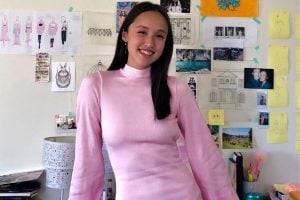
There are a lot of rules about what you can and can’t wear before Memorial Day but DMSE alumna, and sustainable business owner Lauren Choi is working to ensure sustainability is fashionable in any season. Choi started The New Norm team as part of her senior design project in 2020 and after creating a machine capable of recycling plastic into a filament for fabric. The New Norm Team went on to win second place for the Biscotti Foundation Prize for Student Entrepreneurship in 2020, and took first place in the JHU Business Plan Competition’s “General Enterprise and Technology” category that same year. Based in Los Angeles, Choi is working to put her sustainable fabric company at the forefront of the fashion industry.
Q&A
How is the fabric made?
The New Norm creates unique fiber blends made from different recycled materials. I like to compare the process to baking. When you bake, you have to mix a bunch of different components at specific ratios and bake them at a temperature for a certain amount of time to achieve a successful final product. The same goes for polymer blending. Fibers are extremely delicate. They don’t like anything added to them and will not extrude unless perfect conditions are met. My job is to create the perfect recipe “blends” that incorporate varying amounts of different recycled content.
Your senior design project at JHU focused on recycling Red Solo Cups into the filament. Is the New Norm, still focusing on the use of the famous cups or are you incorporating other plastics?
The major barrier to our present-day recycling infrastructure is the staggering amount of different plastic types entering the recycling stream, making it extremely difficult to sort different recyclables. Many plastics labeled with the typical triangle-logo indicating their recyclability are highly engineered and actually cannot be recycled at scale.
The New Norm addresses this issue head-on: We offer a solution that makes use of plastics that are not accepted by our existing recycling infrastructure. Our first trial successfully incorporated the red Solo cup—a material not recycled in the U.S. and not used in fabric—into a fiber that can be manufactured on industrial machinery..
This year, The New Norm is incorporating various polymers to expand our repertoire and increase the types of materials we recycle. For example, we will be recycling Solo cups, ocean and curbside plastics, old fishing nets, and used ropes in our fiber blends. The new plastics we are adding to our repertoire have been collected and diverted from our oceans and landfills.
What are the trends you’re seeing in the fashion industry regarding sustainability? What role do you hope the New Normal will play in shaping the future of sustainable fashion?
There is definitely a push to implement more sustainable practices and develop sustainable products. However, many are critical of how slow wide-scale change has really been. One example [is] the fact that more “organic” cotton is sold than produced, meaning a significant amount of “organic” cotton is NOT organic. I believe global fashion brands are finally realizing they must implement real changes to meet modern consumer demands.
My hope is that The New Norm can inspire real consumer change. Any company that uses The New Norm fabric will be able to claim that they have a truly sustainable and transparent supply chain. From the beginning, having a reliable, sustainable supply chain has been a priority and has been built into the business model. It’s a key component of our product design. Ultimately, I hope The New Norm plays a role in bringing the fashion and recycling industries together and helps to move our world towards a more circular economy. It’s possible: now it’s up to us to make tangible, impacting changes.
Visit The New Norm online to learn more about their mission, processes, and vision for the future of sustainable fashion and find the New Norm team’s Design Day 2021 presentation here.